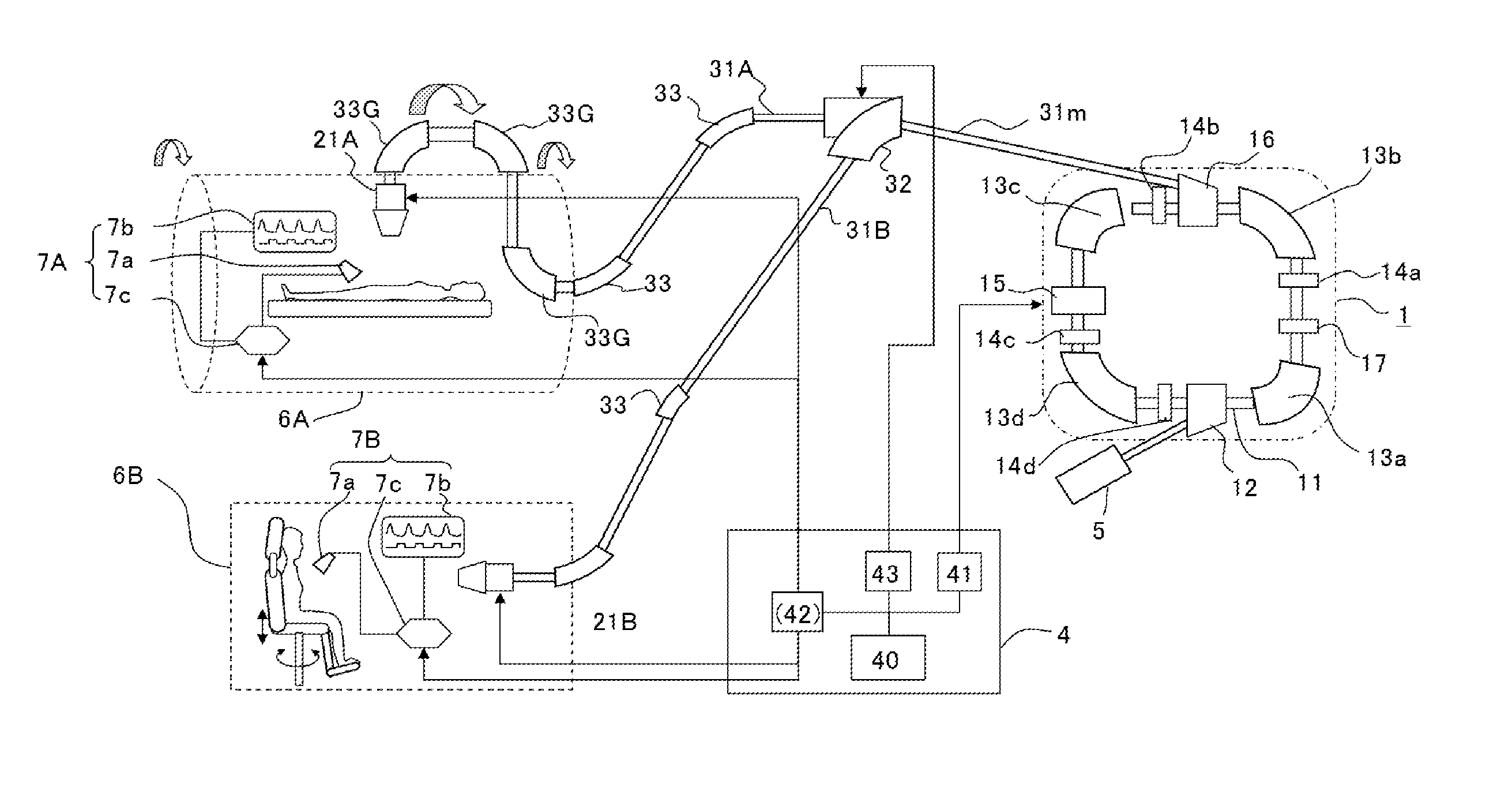Respiratory induction apparatus, respiratory induction program, and particle beam therapy system
a technology of induction apparatus and respiratory induction program, which is applied in the field of respiratory induction apparatus, respiratory induction program, and particle beam therapy system, can solve the problems of inability to accurately evaluate respiration, inability to implement appropriate control or instruction, and inability to achieve optimum timing for irradiation
- Summary
- Abstract
- Description
- Claims
- Application Information
AI Technical Summary
Benefits of technology
Problems solved by technology
Method used
Image
Examples
embodiment 1
[0029]The configuration of a respiratory induction apparatus (respiratory navigation apparatus) according to Embodiment 1 of the present invention and the configuration of a particle beam therapy system provided with the respiratory induction apparatus will be explained below. FIGS. 1 through 7 are to explain the configurations of a respiratory induction apparatus and a particle beam therapy system according to Embodiment 1 of the present invention; FIG. 1 is a diagram illustrating the whole configuration of a particle beam therapy system; FIG. 2 is a functional block diagram for explaining the configuration related to control of a particle beam therapy system; FIG. 3 is a waveform chart representing the relationship among a (desired) respiratory signal, an evaluation function, and a respiration gate signal; FIG. 4 is a complex plane graph representing the relationship among the gain and the phase when a respiratory signal is evaluated by utilizing an evaluation function; FIG. 5 is ...
embodiment 2
[0097]It goes without saying that in the respiratory induction apparatus 7 according to Embodiment 1, the respective portions, represented in the block diagram of FIG. 6, for performing, for example, the operation represented in FIG. 8 can be configured by use of dedicated hardware. However, it can be understood that the functions of the portions, in the respiratory induction apparatus 7, other than the respiration synchronization sensor 7a among the portions illustrated in FIG. 6 can be realized by a universal computer or a workstation. That is to say, in the case where it is assumed that a universal computer or a workstation is utilized, most of the functions in respiratory navigation can readily be realized by use of a program that works on the computer or the like. Accordingly, in Embodiment 2, there will be explained a program for realizing a respiratory induction apparatus on a computer. In Embodiment 2, this program is referred to as a “respiratory induction program according...
embodiment 3
[0106]In Embodiment 3 of the present invention, in the quantitative evaluation of respiration, there is implemented a comprehensive evaluation in addition to the evaluation of the gain and the phase, described in Embodiments 1 and 2. The method in which real respiration is most directly evaluated is a method of evaluating the error between the real respiratory signal Rrl(t) and the desired respiratory signal Rtj(t) as represented in the equation (5).
Jres:=∫02π(Rrl(t)−Rtj(t))2dωrest (5)
where Jres is an evaluation function.
[0107]In the equation (5), the evaluation function Jres is given as a function of continuous time; however, as explained in the “calculation performed every sampling period” of Embodiment 1, Jres is discretely calculated in practice. As is the case with the equation (2), the integration range of the equation (5) for calculating the evaluation function Jres is a single respiration period Tres. Accordingly, as is the case with the equation (2), it is conceivable that...
PUM
 Login to View More
Login to View More Abstract
Description
Claims
Application Information
 Login to View More
Login to View More - R&D
- Intellectual Property
- Life Sciences
- Materials
- Tech Scout
- Unparalleled Data Quality
- Higher Quality Content
- 60% Fewer Hallucinations
Browse by: Latest US Patents, China's latest patents, Technical Efficacy Thesaurus, Application Domain, Technology Topic, Popular Technical Reports.
© 2025 PatSnap. All rights reserved.Legal|Privacy policy|Modern Slavery Act Transparency Statement|Sitemap|About US| Contact US: help@patsnap.com



